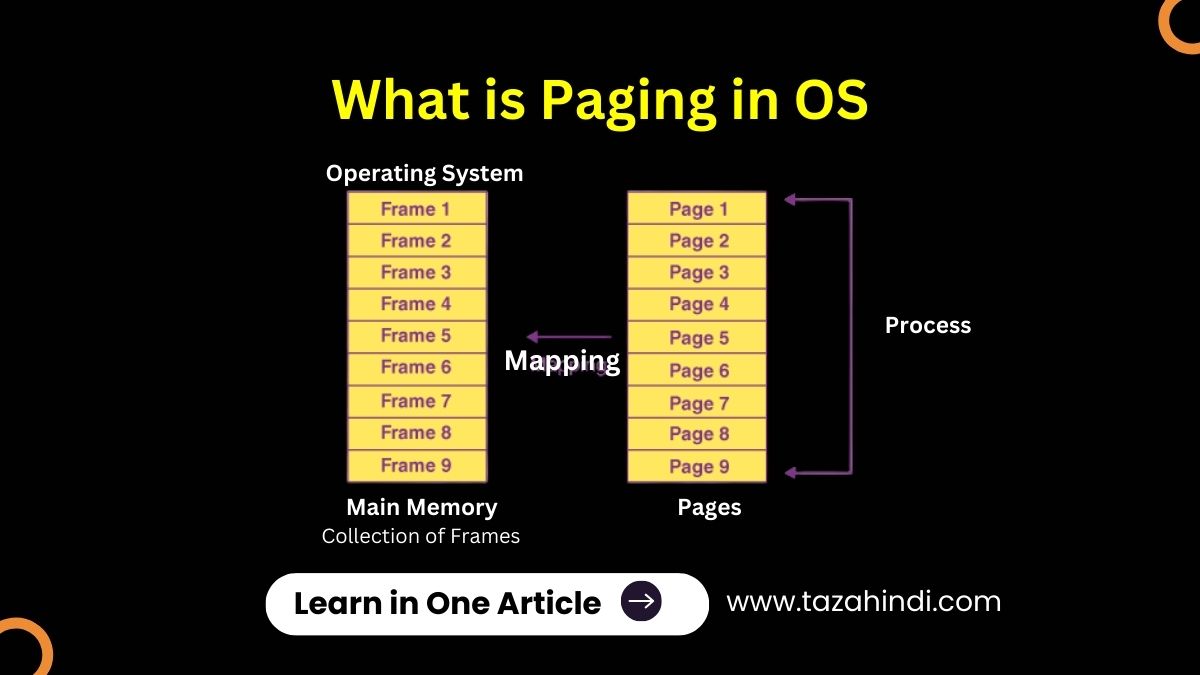In the realm of operating systems, paging stands as a crucial memory management technique that enables processes to access more memory than what is physically available. By dividing both the main memory and the logical address space of a process into fixed-size blocks, paging facilitates efficient memory utilization and eliminates the need for contiguous memory allocation.
In this article, we will explore what paging is, the different types of paging, its advantages and disadvantages, examples of paging in operating systems, how it works and how it differs from swapping.
What is Paging in Operating System?
Paging, a memory management technique employed by operating systems, partitions both the main memory and the logical address space of a process into blocks of equal size, termed pages. These pages serve as the fundamental units of data transfer between the secondary storage, such as a hard disk drive, and the main memory, enabling efficient memory utilization and eliminating the requirement for contiguous memory allocation.
Types of Paging in Operating System
Two primary types of paging exist in operating systems:
- Flat Paging: In flat paging, the entire logical address space of a process is mapped to a single page table. This approach simplifies memory management but can become inefficient for large address spaces.
- Hierarchical Paging: Hierarchical paging addresses the limitations of flat paging by introducing a multi-level page table structure. This structure divides the logical address space into smaller segments, each with its own page table, enhancing memory management efficiency for large address spaces.
Example of Paging in Operating System
Consider a process with a logical address space of 16 pages and a main memory capable of accommodating only 8 pages simultaneously. Paging allows the operating system to store the inactive pages in secondary storage and load them into main memory as they are needed. This dynamic memory management ensures that the process can access its entire address space, even with limited main memory.
Advantages of Paging
Paging offers several advantages, including:
- Efficient Memory Utilization: Paging enables efficient memory utilization by allowing processes to access more memory than is physically available.
- Elimination of External Fragmentation: Paging eliminates external fragmentation, a common issue in contiguous memory allocation, where unused memory blocks become unusable due to their scattered distribution.
- Support for Non-Contiguous Memory Allocation: Paging supports non-contiguous memory allocation, allowing processes to occupy scattered memory blocks without affecting their functionality.
Disadvantages of Paging
Despite its advantages, paging also has some drawbacks:
- Increased Memory Overhead: Paging introduces additional memory overhead due to the maintenance of page tables, which store page-to-frame mappings.
- Translation Lookaside Buffer (TLB) Misses: TLB misses, instances where the TLB fails to find the required page-to-frame mapping, can lead to performance penalties due to the need to access the page table in main memory.
- Complexity: Paging introduces complexity compared to simpler memory management techniques, such as contiguous allocation.
How does Paging Work?
The paging mechanism involves several steps:
- Address Translation: When a process generates a logical address, the operating system translates it into a physical address using the page table.
- Page Fault Handling: If the requested page is not present in main memory, a page fault occurs. The operating system then retrieves the required page from secondary storage and loads it into main memory, updating the page table accordingly.
- Memory Protection: Paging facilitates memory protection by enforcing access restrictions to specific pages, preventing unauthorized access to sensitive data.
Difference between Swapping and Paging
Swapping and paging are both memory management techniques that utilize secondary storage to extend the available memory for processes. However, they differ in their implementation and purpose:
- Purpose: Paging primarily serves to facilitate efficient memory utilization and eliminate external fragmentation, while swapping aims to temporarily remove inactive processes from main memory to free up space for active processes.
- Frequency: Paging occurs frequently as processes access different parts of their address space, while swapping occurs less frequently, typically when main memory becomes heavily utilized.
- Granularity: Paging operates at the page level, moving individual pages between main memory and secondary storage, while swapping operates at the process level, moving entire processes between main memory and secondary storage.
Video Tutorial on What is Paging in Operating System
Conclusion
Paging stands as a fundamental memory management technique employed by operating systems, enabling processes to access more memory than is physically available. Its ability to efficiently utilize memory, eliminate external fragmentation, and support non-contiguous memory allocation makes it a valuable tool for managing memory resources in modern operating systems. While paging introduces some overhead due to page table maintenance and TLB misses, its advantages far outweigh its drawbacks, making it an essential component of efficient memory management.
Also Read :



